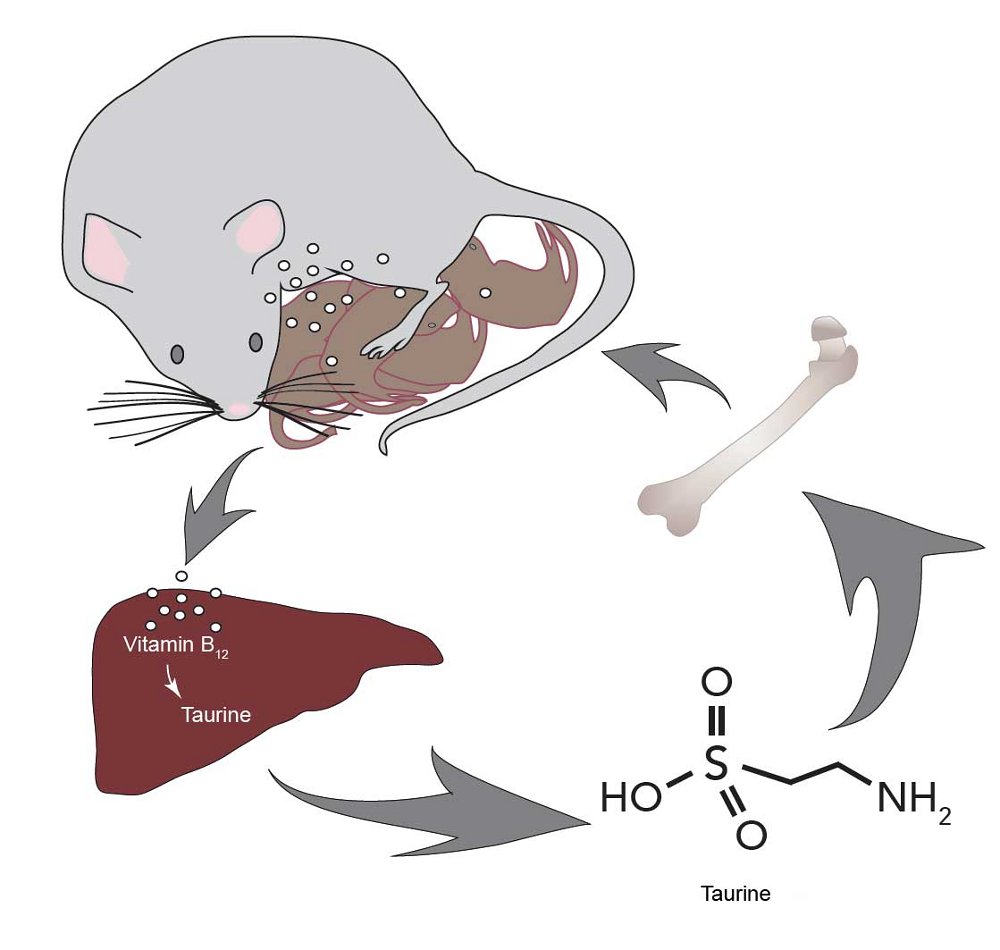Pathway between gut and liver regulates bone mass
Researchers have uncovered a previously unknown biological process involving vitamin B12 and taurine that regulates the production of new bone cells. This pathway could be a potential new target for osteoporosis treatment.
In humans it is well known that vitamin deficiencies lead to stunted growth, but the underlying mechanisms have long been a mystery. In this study, the team was able to piece together the biological process that leads to the production of new bone by studying the offspring of mice lacking the Gastric Intrinsic Factor gene, which is active in the stomach and allows the gut to absorb vitamin B12.
“Bone cells aren’t solely studied in isolation in the lab as both local and systemic factors play an important role in their function, so it’s important to unpick the multitude of biological factors that can affect their proliferation. We were amazed to find a new system that controls bone mass through a protein expressed, of all the places, in the stomach.”
Dr Pablo Roman-Garcia A first author from the Wellcome Trust Sanger Institute

Reducing vitamin B12 levels in bone cells in the laboratory did not affect the function of the bone-forming cells directly, while under the same conditions it affected liver cell functions profoundly. These findings suggested to researchers that the liver has an important role to play. This was confirmed when they showed that liver cells from the offspring of B12-deficient mothers were unable to produce taurine. When these mice were fed regular doses of taurine at three weeks of age, they recovered bone mass and grew normally.
“While the importance of taurine is yet to be fully understood, this research shows that vitamin B12 plays a role in regulating taurine production and that taurine plays an important role in bone formation. To date we have focussed only on vitamin B12-deficient populations, but the next stages of this research will need to confirm the connection between vitamin B12, taurine and bone formation in general populations.”
Dr Vidya Velagapudi Head of the Metabolomics Unit at the Institute for Molecular Medicine Finland
While the focus of this study was the impact of maternal vitamin B12 deficiency on offspring in mouse models, there are promising parallels between these findings and data from human patients. Samples collected by Kocaeli University Hospital, Turkey from children born of nutritionally vitamin B12-deficient mothers also showed a significant decrease in levels of vitamin B12 and taurine. In addition, older patients with vitamin B12 deficiency from a study by the Institute for Molecular Medicine, Finland displayed a statistically positive correlation, suggesting that vitamin B12 plays a key role in regulating taurine synthesis and bone formation in humans of all ages.
“The discovery of this unanticipated pathway between gut, liver and bone would not have been possible without the use of mouse molecular genetics and studies in the clinic that allowed us to understand interactions between these organs. The fact that the vitamin B12-taurine-bone pathway affects only bone formation and appears to play the same role in mice and human beings raises the prospect that targeting this pathway through pharmacological means could be a novel approach toward an anabolic treatment of osteoporosis.”
Dr Vijay K Yadav Senior author from the Sanger Institute
More information
Notes
Osteoporosis is characterised by low bone density and increased risk of fractures and it affects millions of people throughout the world. The incidence of osteoporosis is rising so there is an urgent need to identify molecules that can be targeted for treatment.
One of the major causes of osteoporosis in humans is a defect in ovaries that impairs their ability to produce oestrogen. This observation suggests that organs distant from bone profoundly affect how much bone mass an individual has. While hunting for such organ system level interactions this new study discovered that interactions between stomach and liver are essential for production of new bone.
Funding
This work was supported by the Wellcome Trust (Grant Number: 098051) and European Renal Association-European Dialysis and Transplant Association (ERA-EDTA LTF-78/2011 and 107/2012).
Participating Centres
- A full list of participating centres can be found on the paper.
Publications:
Selected websites
The Institute for Molecular Medicine Finland
The Institute for Molecular Medicine Finland (FIMM) is an international research institute in Helsinki focusing on human genomics and personalized medicine. FIMM is hosted by the University of Helsinki and is part of the Nordic EMBL Partnership in Molecular Medicine. FIMM integrates molecular medicine research, technology center and biobanking infrastructures ‘under one roof’ and thereby promotes translational research and adoption of personalised medicine in health care. FIMM Technology Centre and Biobanking Infrastructures provide research services for local, national and international customers. In 2013, FIMM had a staff of 187 and an annual budget of 16.4 M€, with competitive external funding accounting for over 60 per cent of the budget.
The Wellcome Trust Sanger Institute
The Wellcome Trust Sanger Institute is one of the world’s leading genome centres. Through its ability to conduct research at scale, it is able to engage in bold and long-term exploratory projects that are designed to influence and empower medical science globally. Institute research findings, generated through its own research programmes and through its leading role in international consortia, are being used to develop new diagnostics and treatments for human disease.
The Wellcome Trust
The Wellcome Trust is a global charitable foundation dedicated to achieving extraordinary improvements in human and animal health. We support the brightest minds in biomedical research and the medical humanities. Our breadth of support includes public engagement, education and the application of research to improve health. We are independent of both political and commercial interests.


